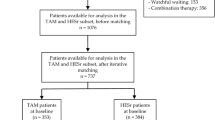Abstract
In two large, multicenter, double-blind, parallel, US phase III clinical trials, men with benign prostatic hyperplasia were randomized to receive tamsulosin, either 0.4 or 0.8 mg daily, or placebo for 13 weeks. Efficacy was determined by changes from baseline in American Urological Association (AUA) symptom scores and peak urinary flow and by percentages of responders with clinically meaningful (> 25%) AUA score improvement and at least 30% increase in peak urinary flow. Secondary efficacy parameters were AUA and Boyarsky irritative, obstructive, and individual scores; investigators’ global assessment; and a total quality-of-life evaluation. Also analyzed were laboratory test results and adverse events, including orthostatic and antihypertensive effects. A trend toward statistically significant improvement occurred in all primary and secondary efficacy endpoints at both dosages versus placebo, except for peak urinary flow rate at endpoint in one trial with 0.4 mg of tamsulosin (P = .064). Urinary flow rates increased within hours after first tamsulosin dose. No clinically or statistically meaningful sitting blood pressure or symptomatic orthostatic changes were seen, and no physical findings or alterations in laboratory or electrocardiographic results were attributable to treatment. Tamsulosin 0.4 and 0.8 mg daily had a rapid onset of action and was effective and well tolerated, with minimal differences observed between dosage groups. The incidence of side effects was similar to that with placebo, and efficacy was sustained with 0.4 mg daily.
Similar content being viewed by others
References
Lepor H. Medical therapy for benign prostatic hyperplasia.Urology. 1993;42:483–501.
Caine M, Raz S, Zeigler M. Adrenergic and cholinergic receptors in the human prostate, prostate capsule, and bladder neck.Br J Urol. 1975;47:193–202.
Caine M, Pfau A, Perlberg S. The use of alpha-adrenergic blockers in benign prostatic obstruction.Br J Urol. 1976;48:255–263.
Wilde M, McTavish D. Tamsulosin. A review of its pharmacological properties and therapeutic potential in the management of symptomatic benign prostatic hyperplasia.Drugs. 1996;52:883–898.
Kirby R. Doxazosin in benign prostatic hyperplasia: effects on blood pressure and urinary flow in normotensive and hypertensive men.Urology. 1995;46:182–186.
Lepor H. Long-term efficacy and safety of terazosin in patients with benign prostatic hyperplasia.Urology. 1995;45:406–413.
McKiernan J, Lowe F. Side effects of terazosin in the treatment of symptomatic benign prostatic hyperplasia.South Med J. 1997;90:509–513.
Kaplan S, Kaplan N. Alpha-blockade: monotherapy for hypertension and benign prostatic hyperplasia.Urology. 1996;48:541–550.
Coffey DS. Controversies in the management of lower urinary tract symptoms: an overview.BrJSurg. 1998;81(suppl 1):1–5.
Lowe FC. Efficacy and tolerability of tamsulosin in patients < 65 years and≥65 years with benign prostatic hyperplasia.J Urol. 1999;161(4 suppl):267. Abstract.
Yamada S, Tanaka C, Kimura R, Kawabe K. Alpha1-adrenoceptors in human prostate: characterization and binding characteristics of alpha1-antagonists.Life Sci. 1994;54:1845–1854.
Verhaeverbeke I, Mets T. Drug-induced hypotension in the elderly: avoiding its onset.Drug Saf. 1997;17:105–118.
Schulman CC, Cortvriend J, Jonas U, et al. Tamsulosin, the first prostate-selective alpha1A-adrenoceptor antagonist.Eur Urol. 1996;29:145–154.
Lepor H. Phase III multicenter placebo-controlled study of tamsulosin in benign prostatic hyperplasia.Urology. 1998;51:892–900.
Narayan P, Tewari A, members of United States 93-01 Study Group. A second phase III multicenter placebo controlled study of 2 dosages of modified release tamsulosin in patients with symptoms of benign prostatic hyperplasia.J Urol. 1998;160:1701–1706.
Tammela T. Benign prostatic hyperplasia: practical treatment guidelines.Drugs Aging. 1997; 10:349–366.
de Mey C, Michel MC, McEwen J, Moreland T. A double-blind comparison of terazosin and tamsulosin on their differential effects on ambulatory blood pressure and nocturnal orthostatic stress testing.Eur Urol. 1998;33:481–488.
Author information
Authors and Affiliations
Rights and permissions
About this article
Cite this article
Narayan, P., Bruskewitz, R. A comparison of two phase III multicenter, placebo-controlled studies of tamsulosin in BPH. Adv Therapy 17, 287–300 (2000). https://doi.org/10.1007/BF02850012
Issue Date:
DOI: https://doi.org/10.1007/BF02850012




